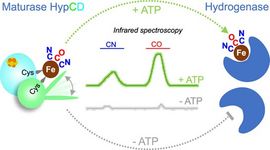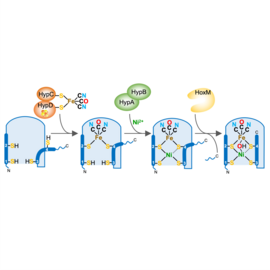Dr. Ingo Zebger
Research interests
- Elucidation of molecular processes, e.g. electron transfer and catalytic mechanisms in redox proteins and metalloenzymes (hydrogenases, formate, CO dehydrogenases).
- Adaptation of vibrational spectroscopic methods to study metalloproteins in solution, in the crystalline and immobilized state.
- Resonance Raman, static / time-resolved IR and surface enhanced vibrational spectroscopies (SERRS, SEIRA) in combination with electrochemical methods.
Research Units in UniSysCat
Publications (selection)
T. G. A. A. Harris, N. Heidary, J. Kozuch, S. Frielingsdorf, O. Lenz, M. A. Mroginski, P. Hildebrandt, I. Zebger, A. Fischer, In situ spectroelectrochemical studies into the formation and stability of robust diazonium-derived interfaces on gold electrodes for the immobilization of an oxygen-tolerant hydrogenase, ACS Applied Materials & Interfaces 2018, 10, 23380–23391.
N. J. Lindenmaier, S. Wahlefeld, E. Bill, T. Szilvási, C. Eberle, S. Yao, P. Hildebrandt, M. Horch, I. Zebger, M. Driess, An S-Oxygenated [NiFe] Complex Modelling Sulfenate Intermediates of an O2-Tolerant Hydrogenase. Angewandte Chemie International Edition 2017, 56, 2208–2211.
A. Ciaccafava, D. Tombolelli, L. Domnik, J. H. Jeoung, H. Dobbek, M. A. Mroginski, I. Zebger, P. Hildebrandt, Carbon Monoxide Dehydrogenase Reduces Cyanate to Cyanide. Angewandte Chemie International Edition 2017 56: 7398–7401.
S. Katz, J. Noth, M. Horch, H.S. Shafaat, T. Happe, P. Hildebrandt, I. Zebger , Vibrational spectroscopy reveals the initial steps of biological hydrogen evolution. Chemical Science 2016, 7, 6746–6752.
M. Horch, L. Lauterbach, M.A. Mroginski, O. Lenz, P. Hildebrandt, I. Zebger, Reversible active site sulfoxygenation can explain the oxygen tolerance of a NAD+-reducing [NiFe] hydrogenase and its unusual infrared spectroscopic properties, Journal of the American Chemical Society 2015, 137, 17897-17905.
M. Horch, P. Hildebrandt, I. Zebger, Concepts in bio-molecular spectroscopy: vibrational case studies on metalloenzymes, Physical Chemistry Chemical Physics 2015, 17, 18222–18237.
M. Horch, J. Schoknecht, M.A. Mroginski, O. Lenz, P. Hildebrandt, I. Zebger, Resonance Raman Spectroscopy on [NiFe] Hydrogenase Provides Structural Insights into Catalytic Intermediates and Reactions, Journal of the American Chemical Society 2014, 136: 9870–9873.
D. Millo, P. Hildebrandt, M.E. Pandelia, W. Lubitz, I. Zebger, SEIRA Spectroscopy of the Electrochemical Activation of an Immobilized [NiFe] Hydrogenase under Turnover and Non-Turnover Conditions, Angewandte Chemie International Edition 2011, 50, 2632–2634.
M. Horch, L. Lauterbach, M. Saggu, O. Lenz, P. Hildebrandt, F. Lendzian, R. Bittl, I. Zebger Probing the active site of an oxygen-tolerant NAD+ reducing [NiFe] hydrogenase from Ralstonia eutropha H16 by in-situ EPR and FTIR spectroscop, Angewandte Chemie International Edition 2010, 49, 8026–8029.
N. Wisitruangsakul, I. Zebger, K. H. Ly, D. H. Murgida, P. Hildebrandt, Redox-linked protein dynamics probed by time-resolved Surface enhanced infrared absorption spectroscopy, Physical Chemistry Chemical Physics 2008, 10, 5276–5286.



